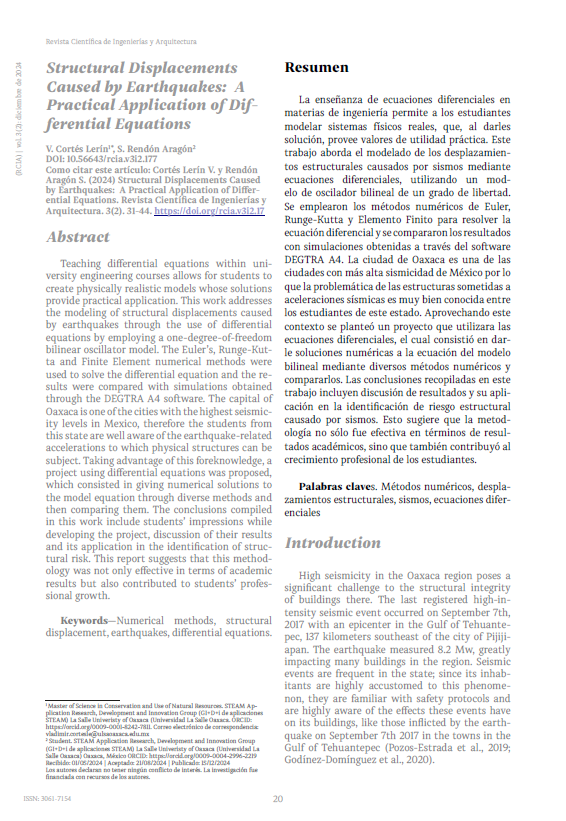Structural Displacements Caused by Earthquakes: A Practical Application of Differential Equations
DOI:
https://doi.org/10.56643/rcia.v3i2.177Palabras clave:
Numerical methods, structural displacement, earthquakes, differential equationsResumen
Teaching differential equations within university engineering courses allows for students to create physically realistic models whose solutions provide practical application. This work addresses the modeling of structural displacements caused by earthquakes through the use of differential equations by employing a one-degree-of-freedom bilinear oscillator model. The Euler’s, Runge-Kutta and Finite Element numerical methods were used to solve the differential equation and the results were compared with simulations obtained through the DEGTRA A4 software. The capital of Oaxaca is one of the cities with the highest seismicity levels in Mexico, therefore the students from this state are well aware of the earthquake-related accelerations to which physical structures can be subject. Taking advantage of this foreknowledge, a project using differential equations was proposed, which consisted in giving numerical solutions to the model equation through diverse methods and then comparing them. The conclusions compiled in this work include students’ impressions while developing the project, discussion of their results and its application in the identification of structural risk. This report suggests that this methodology was not only effective in terms of academic results but also contributed to students’ professional growth.
Referencias
Godínez-Domínguez, E., Tena-Colunga, A., Archundia-Aranda, H., Gómez-Bernal, A., Ruíz-Torres, R., & Escamilla-Cruz, J. (2020). Structural damage in housing and apartment buildings during the September 7, 2017 Tehuantepec earthquake. In Proceedings of the 17th World Conference on Earthquake Engineering.
Hamilton, E., Lesh, R., Lester, F., & Brilleslyper, M. (2008). Model-eliciting activities (MEAs) as a bridge between engineering education research and mathematics education research. Advances in Engineering Education, 1(2). Retrieved from http://eric.edu.gov/?id=EJ1076067
Kim, H., & Melhem, H. (2004). Damage detection of structures by wavelet analysis. Engineering Structures, 26(3), 347-362. https://doi.org/10.1016/j.engstruct.2003.10.008
Montuori, R., Nastri, E., & Tagliafierro, B. (2021). Residual displacements for non-degrading bilinear oscillators under seismic actions. Mechanics Research Communications, 111, 103651. https://doi.org/10.1016/j.mechrescom.2020.103651
Pan, T., & Lee, C. (2002). Application of wavelet theory to identify yielding in seismic response of bi-linear structures. Earthquake Engineering and Structural Dynamics, 31(2), 379-398. https://doi.org/10.1002/eqe.113
Pierleoni, P., Marzorati, S., Ladina, C., Raggiunto, S., Belli, A., Palma, L., Cattaneo, M., & Valenti, S. (2018). Performance evaluation of a low-cost sensing unit for seismic applications: Field testing during seismic events of 2016-2017 in Central Italy. IEEE Sensors Journal, 18(16), 6644-6659. https://doi.org/10.1109/JSEN.2018.2850065
Pozos-Estrada, A., Chávez, M. M., Jaimes, M. Á., Arnau, O., & Guerrero, H. (2019). Damages observed in locations of Oaxaca due to the Tehuantepec Mw8.2 earthquake, Mexico. Natural Hazards, 97(3), 623-641. https://doi.org/10.1007/s11069-019-03662-9
Qiu, C., Du, X., Teng, J., Li, Z., & Chen, C. (2021). Seismic design method for multi-story SMA braced frames based on inelastic displacement ratio. Soil Dynamics and Earthquake Engineering, 147, 106794. https://doi.org/10.1016/j.soildyn.2021.106794
Ross, C. C. (2004). Differential equations: An introduction with Mathematica® (2nd ed.). Springer.
Yang, J. N., Lei, Y., & Lin, S. (2004). Hilbert-Huang based approach for structural damage detection. Journal of Engineering Mechanics, 130(1), 85-95. https://doi.org/10.1061/(ASCE)0733-9399(2004)130:1(85)
Zienkiewicz, O. C., & Taylor, R. L. (2005). The finite element method for solid and structural mechanics

Descargas
Publicado
Número
Sección
Licencia
Derechos de autor 2025 Vladimir Cortés Lerín, Sofía Rendón Aragón

Esta obra está bajo una licencia internacional Creative Commons Atribución 4.0.
Los autores/as que publiquen en esta revista aceptan las siguientes condiciones:
- Los autores/as conservan los derechos de autor y ceden a la revista el derecho de la primera publicación, con el trabajo registrado con la licencia de atribución de Creative Commons 4.0, que permite a terceros utilizar lo publicado siempre que mencionen la autoría del trabajo y a la primera publicación en esta revista.
- Los autores/as pueden realizar otros acuerdos contractuales independientes y adicionales para la distribución no exclusiva de la versión del artículo publicado en esta revista (p. ej., incluirlo en un repositorio institucional o publicarlo en un libro) siempre que indiquen claramente que el trabajo se publicó por primera vez en esta revista.
- Se permite y recomienda a los autores/as a compartir su trabajo en línea (por ejemplo: en repositorios institucionales o páginas web personales) antes y durante el proceso de envío del manuscrito, ya que puede conducir a intercambios productivos, a una mayor y más rápida citación del trabajo publicado.








